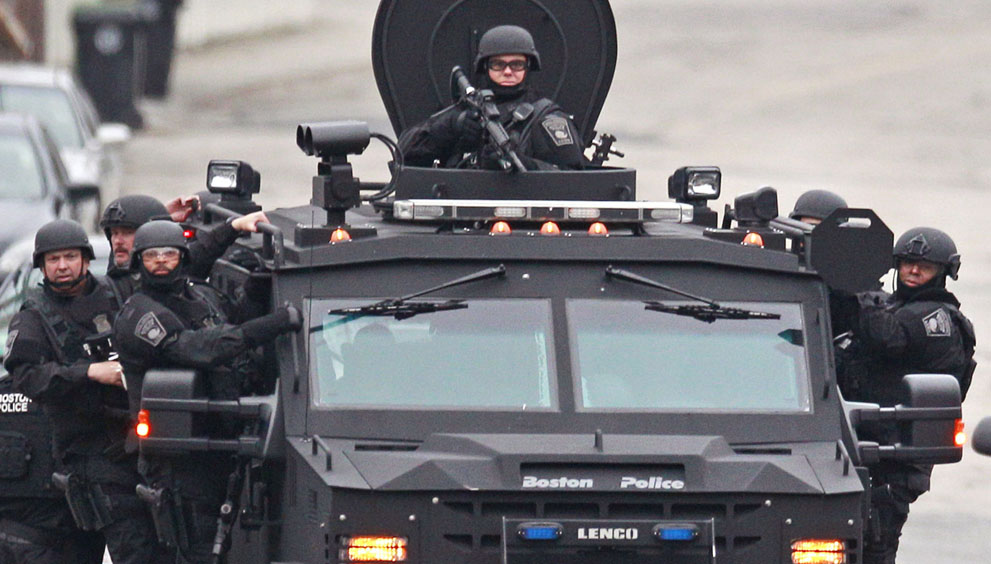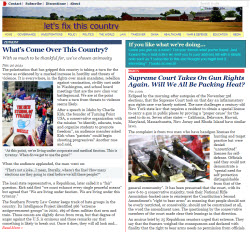Still a Disconnect After All These Years
Government agencies still don’t exchange information? Apr 26 2013The Department of Homeland Security {DHS} knew about the Boston bomber's trip to Russia, despite a misspelled name on his travel documents, the agency's chief, Janet Napolitano, told a Senate subcommittee a week after
Our increasingly militarized police: Do we
really need all this to go after a 19-year-old?
the atrocity. Redundancies in the system caught the disparity and “there was a ping on the outbound to Customs”, one of the divisions of the DHS, she said.
That puzzled Sen. Lindsay Graham (R, SC), who had been told by the FBI that "that they had no knowledge of [Tamerlan Tsarnaev] leaving or coming back".
But the FBI is separate — a part of the Justice Department. Both they and CIA had added the older Tsarnaev to two different watch lists in 2011. CIA notified State and DHS. They had been tipped off by Russian intelligence, suspicious about the U.S. transplant from Dagestan even before he went to Russia. But neither CIA nor FBI noticed when Tsarnaev last year went back to the mother country.
where have we heard that before?What we are hearing is that what one agency knew was not shared with the other and that databases are where information goes to die. Russia had warned the FBI twice, calling the older brother "a follower of radical Islam" who had "changed drastically", yet the FBI dropped the matter because a law prevents them from indefinite surveillance, they now say. That ping to Customs? That was relayed to the Boston area FBI-led Joint Terrorism Task Force. There is no evidence so far that they took any action.
This account and another by the New York Times reminds us of George Tenant warning the president in the summer of 2011 that "the system is blinking red" and yet the signals were once again missed. Here's what it was like in the prelude to 9/11, which we offer to compare progress between then and now.
the 9/11 commission revisitedThe 2004 commission investigating the 9/11 attacks uncovered numerous instances where vital information that might have warned us of the attacks instead disappeared into dead ends, with notorious failings to “connect the dots”. In fact, a structural fault was found right in the 9/11 Commission’s ranks. One of its panelists, Jamie Gorelick, was the author of rules while at the Justice Department that set up “the wall” through which information must not pass, even within the FBI. Agencies were forbidden to pass criminal investigation discoveries to intelligence agencies and vice versa. The CIA was restricted to international, the FBI to domestic. Gorelick’s rules were viewed as an excessive extension of separations originally established by the Church committee in the 1970s.
Partly as a result, unconnected dots littered the landscape before 9/11. Here’s a sampling:
| The 9/11 Commission asked CIA chief George Tenet why CIA had done nothing to track down Marwan al-Shehhi, the pilot who crashed the south tower of the World Trade Center. Thirty months earlier, German intelligence “gave us a name, Marwan — that's it — and a phone number. They didn't give us a first and last name until after 9/11". | |
| Two known Al Qaeda operatives, found by a CIA search of their Dubai hotel room in January 2000 to have valid visas to enter the U.S., were not put on a watch list to block their entry. Not until May 2001 did a CIA agent reopen their case and find that one had come to Los Angeles. An FBI agent was asked to review the material, but “in her free time”. She began on July 24 and learned from the INS that the two might be in country. She informed the FBI’s counter-terror center in New York but labeled her e-mail “routine”, which gave them 30 days to respond. One operative was listed in the San Diego phonebook. Both were 9/11 hijackers. | |
| An FBI field agent in Phoenix reported to Washington in July 2001 that he had discovered young foreigners who might be affiliated with Islamic terrorist groups were seeking flight training. He urged a nationwide investigation of flight schools. There was no follow-up. | |
| In Minneapolis, a flight school alerted the FBI in August 2001 that a student named Moussaoui, a French citizen of Moroccan descent, wanted to learn only how to steer a plane, not how to take off or land. Agents arrested him on immigration charges, then urged superiors in Washington to obtain a warrant to search his belongings, arguing that he appeared to be an Islamic extremist. The warrant was refused. He was later found to have the telephone number in Germany of a ringleader of the terrorist cell that carried out the Sept. 11 attacks. | |
| Richard Clarke, the top White House counter-terrorism adviser, says he was never informed of the two Al Qaeda operatives known to be in the U.S. | |
| FBI director Robert Mueller and his senior deputies say they weren’t informed until after 9/11 about Phoenix and Minneapolis. | |
| The FBI’s arrest of Moussaoui on Aug. 17 was relayed by the FBI-CIA counter-terror center to the highest levels of the CIA, including George Tenet, the Commission reported, but “the news had no evident effect of warning”. Had Moussaoui's name been run through British intelligence files, the CIA would have discovered he had undergone training with Al Qaeda. | |
| The only pre-9/11 meeting on counter-terrorism with the heads of State, Defense, the FBI and the CIA attending was not held until Sept. 4, 2001. Moussaoui wasn’t discussed | |
| Neither the FBI nor Justice were informed of the CIA’s now famous Aug. 6, 2001, President’s Daily Brief (PDB). |
The disappearance of information down rabbit holes is what was supposed to have been fixed, especially with the creation of the enormous Department of Homeland Security, which placed more than a dozen organizations under one roof, from the Coast Guard to FEMA. But not FBI and not CIA nor the archipelago of intelligence agencies and private companies that were born in the aftermath of 9/11 and which constitute the new, secret American security state — secret until exposed in Dana Priest’s and William Arkin’s monumental investigation for the Washington Post. So, instead of consolidation, there has been staggering proliferation, spending and overlap.
And we're not done. There is yet another layer, the Joint Terrorism Task Force, a regional network with each chapter comprised of representatives from the FBI and those same components of Homeland Security we just cited. There are a hundred JTTFs and they come together at the National Joint Terrorism Task Force (NJTTF), headquartered in Washington, DC, and stocked with representatives from no less than 35 federal agencies. There has been no mention yet of whether the Boston unit was at all mindful of the Tsarnaev brothers, which leads one to wonder what use are all the regionals. Are they vigilant or have all the multiple layers simply led to unwieldy bureaucratic bloat and a return to the apparent rule of nature that separate fiefdoms tend to keep information to themselves, to the nation’s detriment, such as we may have seen in Boston.
Please subscribe if you haven't, or post a comment below about this article, or
click here to go to our front page.

